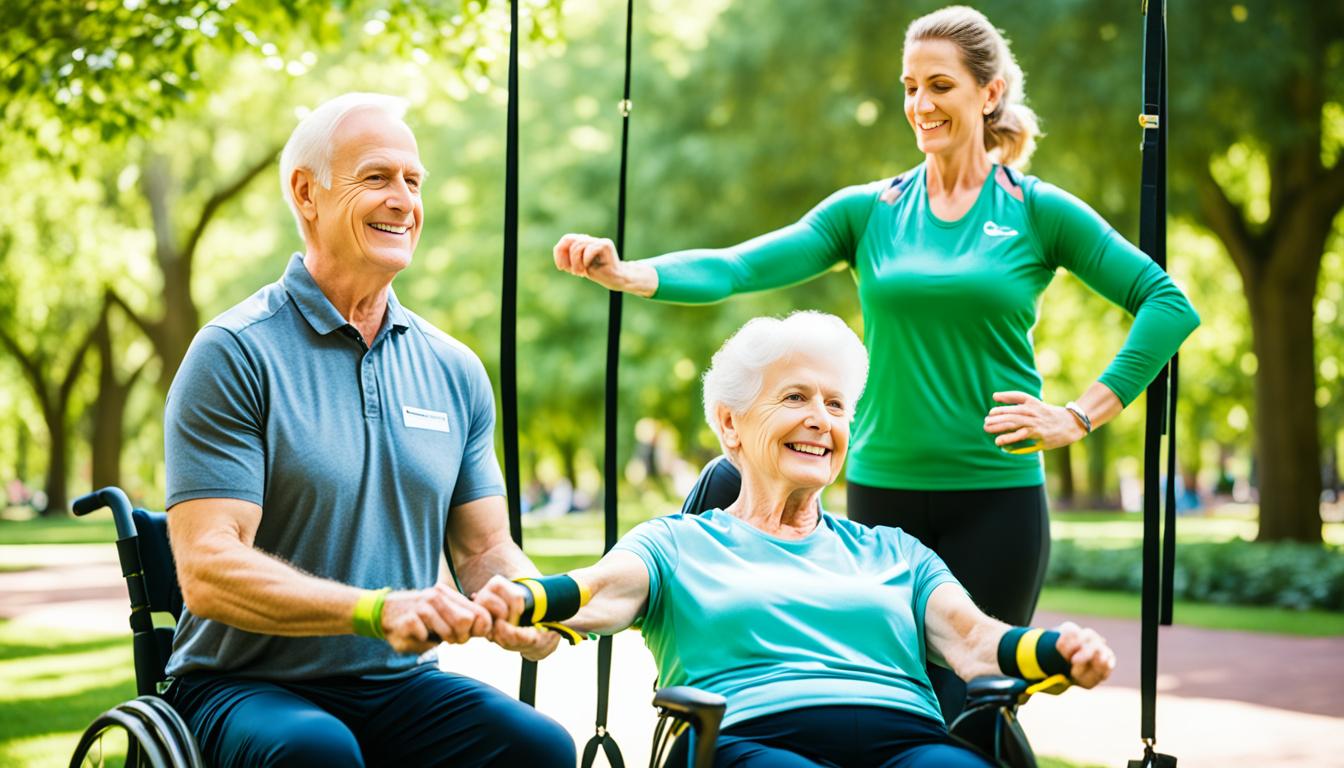If you have a loved one with limited mobility due to chronic illness, injury, or disability, you understand the unique challenges they face. As someone who has spent a decade devoted to caring for my wife, who battles with endometriosis and fibromyalgia, I have gained valuable experience and expertise in adapting physical activities to accommodate limited mobility. Witnessing my wife’s journey has shaped me into the man I am today, and it sparked my passion for blogging. Blogging has been not only therapeutic for me but also a way to escape the new normal and advocate for my ill partner.
Through sharing our experiences and insights, I hope to help others facing similar challenges find adaptive exercises and activities that can improve their loved ones’ overall well-being. In addition to the emotional benefits, blogging has also allowed us to secure our future financially, as it can serve as a source of income. By using my knowledge and expertise to create meaningful content, I aim to support not only my wife but also others who are on the same difficult journey. Join me as we explore the world of adapting physical activities for loved ones with limited mobility.
The Health Benefits of Exercise for Limited Mobility
Regular exercise has numerous health benefits, including improving mood, reducing stress and anxiety, and enhancing overall well-being. This holds true even for individuals with limited mobility. Engaging in exercise can provide mental and emotional benefits that contribute to a better quality of life.
Exercise releases endorphins, which are natural chemicals in the brain that boost mood and create a sense of well-being. These endorphins help alleviate feelings of stress and anxiety, promoting a more positive and balanced state of mind. Whether it’s a gentle stretch routine or seated exercises, incorporating physical activity into your daily routine can have a significant impact on your mental health.
Furthermore, exercise can be beneficial in treating mild to moderate depression. By engaging in regular physical activity, you can increase the production of neurotransmitters in the brain, such as serotonin and dopamine, which are known to improve mood and promote a sense of happiness. This can be especially beneficial for individuals with limited mobility who may face additional challenges and limitations in their daily lives.
The Impact of Exercise on Mental Health
Exercise has been proven to:
- Reduce symptoms of depression and anxiety
- Boost self-esteem and body image
- Improve cognitive function and memory
- Promote better sleep
- Enhance stress management and resilience
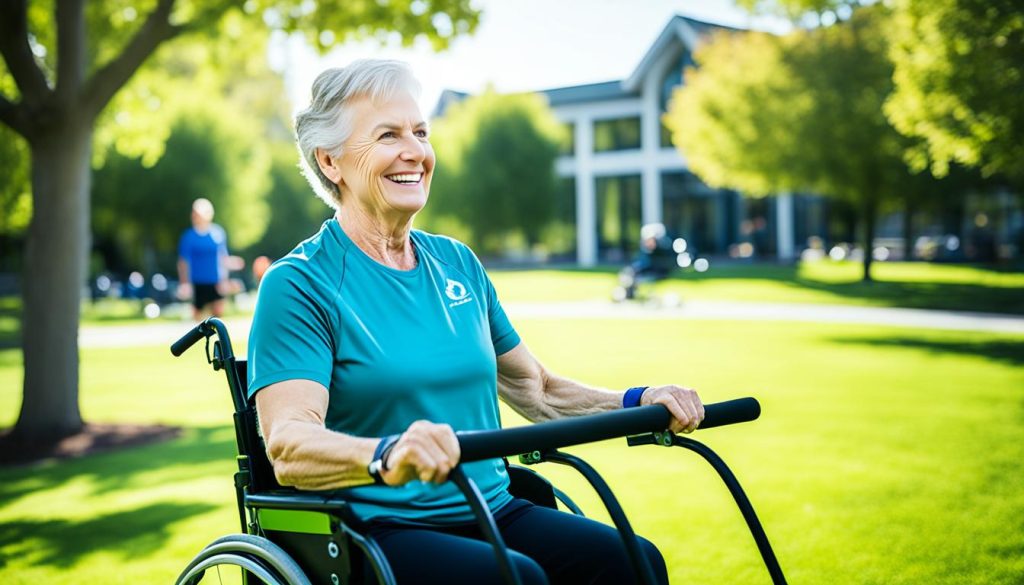
Incorporating exercise into your routine, regardless of your mobility limitations, can contribute to a more positive outlook and improved overall well-being. The physical and mental health benefits are significant, providing additional motivation to prioritize regular physical activity.
Types of Exercises for Limited Mobility
When it comes to maintaining a healthy and active lifestyle with limited mobility, incorporating different types of exercises into your routine is essential. By engaging in cardiovascular exercises, strength training, and flexibility exercises, you can improve your overall well-being and enhance your physical capabilities.
Cardiovascular Exercises
Cardiovascular exercises are designed to elevate your heart rate, increase endurance, and improve cardiovascular health. These exercises not only provide a great workout for your heart and lungs but also help with weight management and stress reduction. For individuals with limited mobility, there are modified options available that are gentle on the joints and muscles.
Strength Training
Strength training exercises focus on building muscle strength and improving balance, which is particularly beneficial for individuals with limited mobility. By strengthening your muscles, you can enhance your overall stability and reduce the risk of falls and injuries. Strength training exercises can be done using resistance bands, weights, or even your own body weight.
Flexibility Exercises
Flexibility exercises are crucial for maintaining and improving range of motion, which is often limited in individuals with mobility challenges. These exercises involve stretching and lengthening the muscles, tendons, and ligaments, promoting flexibility and reducing muscle stiffness. Flexibility exercises can be done in a seated or lying down position and can greatly enhance your mobility and functional ability.
It’s important to note that these exercises can be modified and tailored to suit your specific needs and limitations. Whether you’re a senior with limited mobility or someone with a disability, there are exercises and adaptations available to help you stay active and promote your overall well-being.
To get a better idea of the types of exercises you can incorporate into your routine, take a look at the table below:
| Exercise Type | Description |
|---|---|
| Cardiovascular Exercises | Walking, swimming, water aerobics, cycling |
| Strength Training | Resistance band exercises, seated dumbbell exercises, bodyweight exercises |
| Flexibility Exercises | Yoga, tai chi, stretching exercises |
| Exercises for Seniors with Limited Mobility | Chair exercises, gentle yoga, seated tai chi |
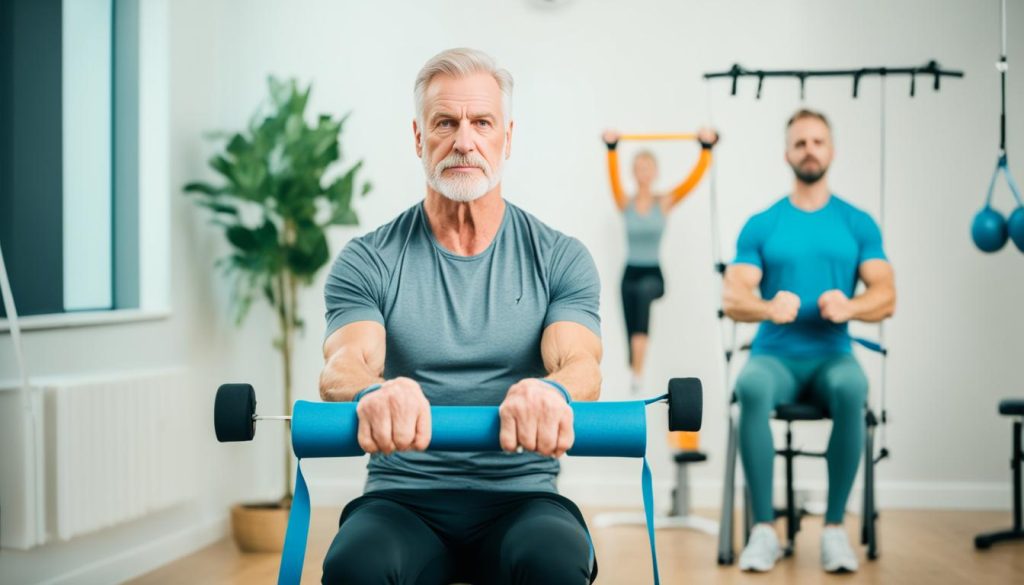
Remember, it’s important to consult with a healthcare professional or a certified exercise specialist to determine the most suitable exercises for your specific condition and limitations. They can provide personalized guidance and ensure that you’re engaging in safe and effective exercises that cater to your unique needs.
Tips for Exercising with Limited Mobility
When it comes to exercising with limited mobility, there are a few key tips to keep in mind. By following these guidelines, you can develop a safe and effective exercise routine that suits your abilities and goals. Remember, always consult with a healthcare professional before starting any new exercise program.
1. Get Medical Clearance
Before beginning any exercise routine, it’s crucial to get medical clearance from your healthcare provider. They can assess your specific condition, offer guidance on exercises that are safe for you, and provide any necessary modifications. Medical clearance ensures that you are taking the appropriate steps to protect your health while incorporating physical activity into your life.
2. Start Slow
When it comes to exercise, it’s important to start slow and gradually increase your activity levels. This allows your body to adapt and prevents overexertion or injury. Begin with exercises that are comfortable and easy to perform, then gradually add more challenging activities as your fitness level improves. Starting slow sets the foundation for a sustainable and long-lasting exercise routine.
3. Make Exercise Part of Daily Life
To make exercise a habit, it’s helpful to incorporate it into your daily life. Find ways to incorporate physical activity throughout your day, such as taking short walks, using stairs instead of elevators, or doing stretching exercises during TV commercial breaks. By making exercise a regular part of your routine, it becomes easier to stick with it and reap the benefits.
4. Stick with It
Consistency is key when it comes to exercise. Even on days when you may not feel motivated or experience setbacks, it’s important to stick with your routine. Remember that progress takes time, and staying committed to your exercise program will yield long-term results. Find ways to stay motivated, such as setting goals, tracking your progress, or finding an exercise buddy to keep you accountable.
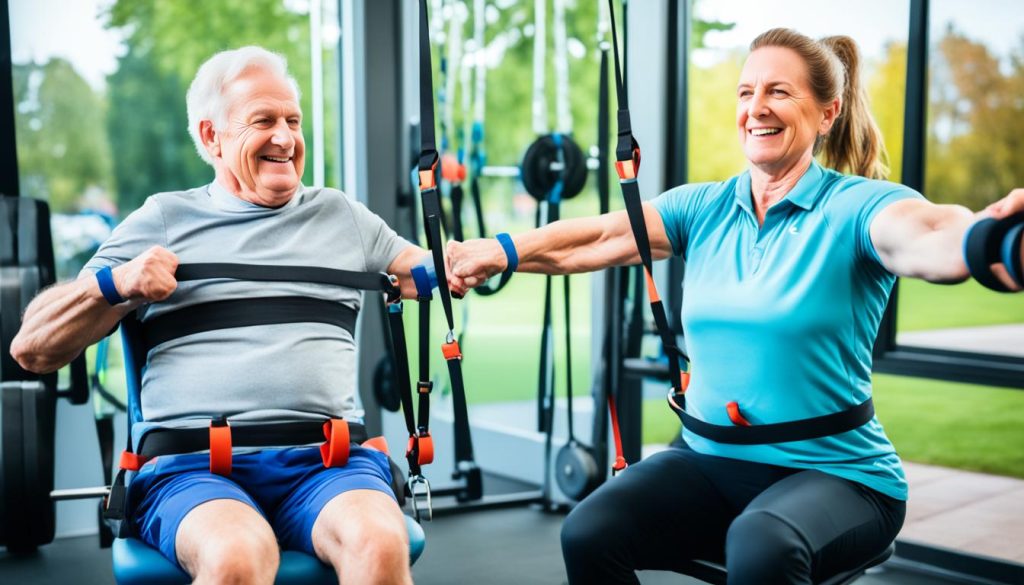
Sample Exercise Routine
| Exercise Type | Frequency | Duration |
|---|---|---|
| Cardiovascular | 3-5 times per week | 20-30 minutes |
| Strength Training | 2-3 times per week | 10-15 minutes |
| Flexibility | Every day | 10-15 minutes |
Remember, this is just a sample exercise routine. Your routine should be tailored to your specific abilities and goals. Be sure to consult with a healthcare professional or a certified exercise specialist to create a personalized plan that suits your needs.
By following these tips and staying committed to your exercise routine, you can improve your overall well-being and enjoy the physical and mental health benefits of regular physical activity. Remember, exercise is a journey, so start slow, make it a part of your daily life, and stick with it for the long haul.
Overcoming Barriers to Exercise for Limited Mobility
Individuals with limited mobility may face various barriers when it comes to exercise. These barriers can include self-consciousness, fear of injury, lack of motivation, lack of coordination, and boredom. However, it’s important to remember that these challenges can be overcome with the right strategies and mindset.
One effective strategy is to find activities that can be done in a more private setting. This can help reduce self-consciousness and allow individuals to focus on their exercise without feeling judged. Consider exercising at home or participating in private group fitness classes.
Choosing low-risk activities is another way to address the fear of injury. Opt for exercises that are gentle on the joints and suitable for your specific condition. Consider activities like swimming, yoga, or tai chi that provide low-impact options while still offering significant health benefits.
Seeking support from friends and family can be a great source of motivation. Having a workout buddy or joining a support group can help maintain accountability and make exercise more enjoyable. By exercising together, you can provide each other with the necessary encouragement to stay on track.
Making exercise fun can also combat the lack of motivation and boredom. One way to achieve this is through activities like exergaming, which combine video games and physical exercise. Exergames can make working out more engaging and enjoyable, providing an entertaining way to stay active.
Remember, overcoming barriers to exercise for limited mobility is possible. With the right strategies, mindset, and support system, individuals with limited mobility can find joy and fulfillment in physical activity, leading to improved overall health and well-being.
| Barrier | Strategies to Overcome |
|---|---|
| Self-consciousness | Find activities that can be done in a more private setting |
| Fear of injury | Choose low-risk activities suitable for your condition |
| Lack of motivation | Seek support from friends and family |
| Lack of coordination | Start with exercises that are easy to follow and gradually build coordination |
| Boredom | Make exercise fun through activities like exergaming |
Activities for Seniors with Limited Mobility
Even with limited mobility, seniors can still engage in a variety of activities that enhance their quality of life. These activities cater to different interests and abilities, ensuring inclusivity for seniors with limited mobility.
1. Listening to Music
Listening to music is a great way for seniors to relax, reminisce, and uplift their spirits. Creating personalized playlists or joining virtual music groups can provide a sense of connection and joy.
2. Engaging in Art and Crafts
Artistic activities such as painting, drawing, and crafting can stimulate creativity and offer a therapeutic outlet for self-expression. Seniors can explore various mediums and techniques based on their interests.
3. Gardening
Gardening provides an opportunity for seniors to connect with nature and engage in gentle physical activity. Whether it’s tending to a flowerbed or growing vegetables in pots, gardening offers a sense of accomplishment and tranquility.
4. Reading
Reading allows seniors to embark on exciting literary journeys, explore different worlds, and expand their knowledge. With the availability of large-print books and audiobooks, reading remains accessible to seniors with visual impairments.
5. Playing Games and Puzzles
Games and puzzles stimulate cognitive function and provide entertainment. Seniors can enjoy board games, card games, crossword puzzles, Sudoku, and jigsaw puzzles, either individually or with the company of loved ones.
6. Chair Exercises
Chair exercises are designed specifically for individuals with limited mobility. These exercises focus on improving strength, flexibility, and balance while seated. Seniors can follow instructional videos or seek guidance from a trained professional.
7. Group Exercise Classes
Group exercise classes tailored for seniors with limited mobility offer a supportive and social environment. These classes promote physical well-being and provide an opportunity to connect with peers who share similar challenges.
8. Walking Clubs
Participating in walking clubs allows seniors to enjoy the benefits of outdoor physical activity while socializing with others. These clubs provide a platform for community engagement and the exploration of local neighborhoods.
Remember, it’s important for seniors with limited mobility to consult with a healthcare professional before starting any new activities, ensuring they are safe and suitable for their specific condition.
| Activity | Description |
|---|---|
| Listening to Music | Listening to music to relax, reminisce, and uplift spirits. |
| Engaging in Art and Crafts | Participating in artistic activities like painting, drawing, and crafting. |
| Gardening | Tending to flowerbeds or growing vegetables in pots. |
| Reading | Embarking on exciting literary journeys and expanding knowledge. |
| Playing Games and Puzzles | Enjoying board games, card games, puzzles, and brain-teasers. |
| Chair Exercises | Performing exercises focused on strength, flexibility, and balance while seated. |
| Group Exercise Classes | Participating in exercise classes tailored for seniors with limited mobility. |
| Walking Clubs | Joining walking clubs for outdoor physical activity and socializing. |
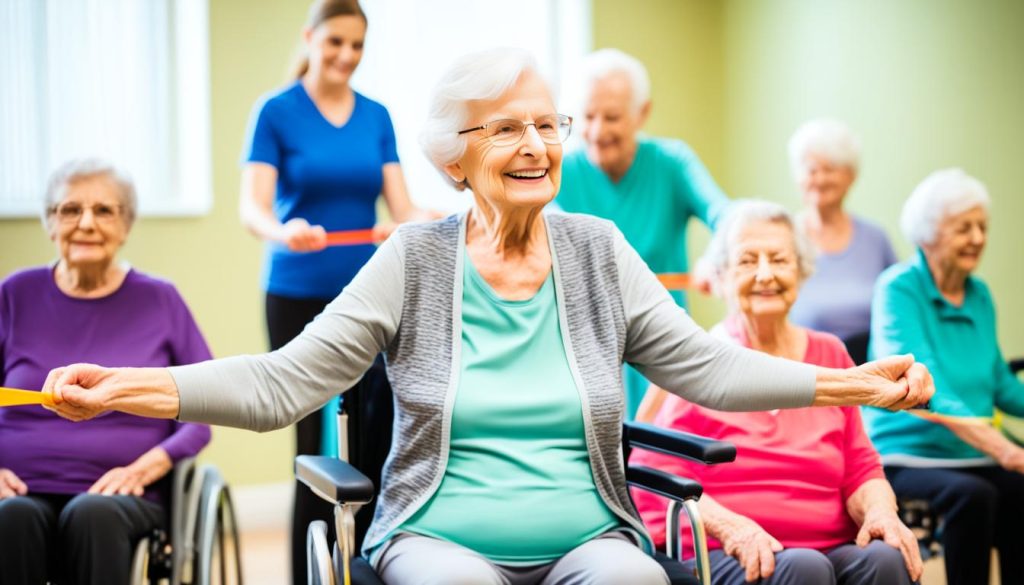
Staying Active in the Community
Engaging in physical activity outdoors, such as walking, can have significant benefits for both your physical and mental health. The fresh air, sunshine, and connection with nature can invigorate your body and rejuvenate your mind. However, it’s important to recognize that adults with disabilities may encounter certain barriers when it comes to walking in their neighborhoods.
Neighborhood Barriers for Walking
Unfortunately, not all communities are designed to be fully inclusive and accessible for individuals with disabilities. Some common neighborhood barriers that may impede walking for people with limited mobility include:
- Lack of curb cuts or ramps
- Uneven or broken sidewalks
- Inadequate crosswalks or pedestrian signals
- Limited availability of accessible parks or trails
- Insufficient lighting or safety measures
These barriers can make it challenging or even unsafe for individuals with disabilities to engage in outdoor walking activities.
Promoting Supportive Environments
To improve accessibility and inclusivity in the community, it is essential to promote supportive environments for walking. This involves advocating for changes and improvements that can remove barriers and create a more welcoming environment for individuals with disabilities. Here are some strategies that can help:
- Collaborate with local authorities and organizations to raise awareness about the importance of inclusive and accessible neighborhoods. Push for the implementation of policies and regulations that prioritize the needs of individuals with disabilities in urban planning.
- Advocate for the installation of curb cuts, ramps, and other mobility aids to ensure that sidewalks and pedestrian pathways are accessible to everyone.
- Encourage the maintenance and repair of sidewalks to prevent hazards such as cracks, holes, or uneven surfaces that can pose challenges for individuals with limited mobility.
- Promote the creation of more accessible parks, trails, and green spaces that offer amenities such as wheelchair-friendly paths, accessible seating, and inclusive recreational activities.
- Support initiatives that improve lighting, visibility, and safety measures in public spaces to provide a more secure and welcoming environment for individuals with disabilities.
By working together to create supportive environments, we can ensure that everyone, regardless of their mobility level, has the opportunity to enjoy outdoor activities and reap the numerous benefits of walking.
Being Active at Home
For individuals with limited mobility, being active at home is a convenient and accessible option. There are various ways you can exercise and stay active without leaving the comfort of your home. Whether it’s through exercise videos, chair exercises, gentle stretching, or therapeutic massage, there are options suited to your abilities and preferences.
Exercise videos are a great resource for staying active at home. You can find a wide range of videos online that cater to different fitness levels and interests. From cardio workouts to strength training and yoga, these videos provide guidance and motivation to help you maintain a regular exercise routine.
Chair exercises are specifically designed to be done while seated, making them suitable for individuals with limited mobility. These exercises target different muscle groups and can help improve strength, flexibility, and balance. You can find chair exercise routines online or consult with a physical therapist for personalized recommendations.
Gentle stretching is another effective way to stay active at home, especially for individuals with limited mobility. Stretching exercises can help improve flexibility, range of motion, and joint mobility. You can incorporate gentle stretches into your daily routine to promote muscle relaxation and reduce stiffness.
In addition to exercise, therapeutic or gentle massage can be beneficial for relaxation and reducing muscle tension. It can also help improve circulation and alleviate pain. Consider incorporating self-massage techniques or seeking the assistance of a professional masseuse to experience the benefits of therapeutic massage at home.
By being active at home, you have the flexibility to choose activities that suit your needs and preferences. Whether it’s following exercise videos, engaging in chair exercises, practicing gentle stretching, or enjoying therapeutic massage, you can maintain an active lifestyle and prioritize your well-being.
CDC Disability Resources
When it comes to promoting health and physical activity for individuals with disabilities, the Centers for Disease Control and Prevention (CDC) offers a variety of valuable resources. These resources serve as helpful guides to ensure that people with disabilities can engage in physical activities that are safe, effective, and tailored to their specific needs.
One of the key resources provided by the CDC is the Physical Activity Guidelines for Americans with Disabilities. These guidelines offer evidence-based recommendations for individuals with disabilities, highlighting the importance of regular physical activity for improving overall health and well-being. They provide detailed information on the types of activities that can be beneficial, the recommended duration and intensity levels, and considerations for specific disabilities.
The CDC also collaborates with the National Centers on Disability to provide support and assistance to individuals with disabilities in their pursuit of an active lifestyle. These centers offer a wealth of information, resources, and programs designed to address the unique challenges faced by people with disabilities. They strive to improve access to health opportunities and enhance the quality of life for individuals with disabilities.
By utilizing the CDC disability resources and following the physical activity guidelines, individuals with disabilities can overcome barriers and engage in activities that promote their health and well-being. Whether it’s incorporating adapted exercises, participating in inclusive programs, or seeking support from the National Centers on Disability, these resources empower individuals with disabilities to lead active and fulfilling lives.
Conclusion
Adapting physical activities for loved ones with limited mobility is essential for their overall well-being and inclusivity. By incorporating modified exercises, engaging in activities catered to their specific needs, and overcoming barriers, individuals with limited mobility can enjoy the numerous physical and mental health benefits of exercise.
It is important to provide support and understanding to loved ones with chronic illnesses as they navigate their journey to maintain an active lifestyle. By being empathetic and acknowledging their unique challenges, you can create a supportive environment that promotes their physical and emotional well-being.
Remember, lifestyle and adaptations play a crucial role in ensuring that your loved ones with limited mobility can participate in activities that bring them joy and fulfillment. By embracing flexibility and finding creative solutions, you can help them explore new avenues for physical activity and lead a fulfilling life despite their limitations.
